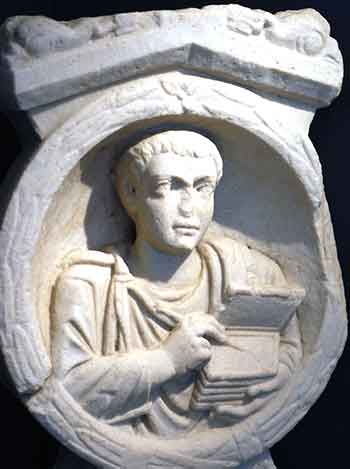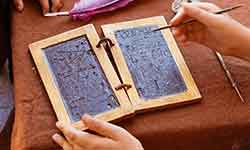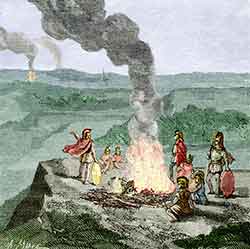Military Signalling
Introduction
 For a short distance message situation, a commanding officer may need to send troops out to a flank position to protect the front line soldiers. He could want to send his company out to one side to cut off an enemy's retreat. He could even need to get a message to advance in numbers. In turn the front line would also want to send messages back to the field commanders
For a short distance message situation, a commanding officer may need to send troops out to a flank position to protect the front line soldiers. He could want to send his company out to one side to cut off an enemy's retreat. He could even need to get a message to advance in numbers. In turn the front line would also want to send messages back to the field commanders
In the short distance, the Roman officers overseeing a battle from an elevated position on a hillside would have a team of runners whose job it as to run at full tilt to the commander of a unit. On arrival they would pass a message verbally, or written on a wax tablet.
 But over longer distances, the utilisation of runners was not an effective means of communicating. When the distances were over a mile, or the units were fighting on several fronts at once, multiple runners were not the answer. So the Romans had to develop a system of communication over longer distances
But over longer distances, the utilisation of runners was not an effective means of communicating. When the distances were over a mile, or the units were fighting on several fronts at once, multiple runners were not the answer. So the Romans had to develop a system of communication over longer distances
The historian Polybius wrote:
How can anyone be of good cheer, or in fact, think at all, if he does not understand how many ships and how much corn have arrived from the allies?
Even today, one of the main requirements of the military is the ability to send messages over both short and long distances.
Fire signals
 The Romans originally used bonfires to communicate messages over long distances. Like many aspects of Roman life, this had been taken from the Greeks. Basically a series of bonfires were erected on hilltops from the scene of a battle to the capital town or city. As one fire was lit, the team at the next one in the chain would see it and light theirs, and so on until the last fire was lit.
The Romans originally used bonfires to communicate messages over long distances. Like many aspects of Roman life, this had been taken from the Greeks. Basically a series of bonfires were erected on hilltops from the scene of a battle to the capital town or city. As one fire was lit, the team at the next one in the chain would see it and light theirs, and so on until the last fire was lit.
The five flags method
The Romans needed a way in which they could communicate specific messages from directly from one place to another. So they developed a system using two sets of five flags that could be raised or lowered. These were no ordinary hand controlled, but poles some 12ft (3.65m) with a rigid triangular or square flag at the top. These flags were normally painted bright red for clarity. There were five flags per group each of them resting against a trestle. The poles hade a pivot point a just above halfway to make them perfectly balanced and easy to manipulate. A short distance away was a second group of five flags.
These were used in conjunction with a master list of the alphabet which was laid out thus:
|
|
I
|
II
|
III
|
IV
|
V
|
|
I
|
A
|
B
|
C
|
D
|
E
|
|
II
|
F
|
G
|
H
|
I
|
J
|
|
III
|
K
|
L
|
M
|
N
|
O
|
|
IV
|
P
|
Q
|
R
|
S
|
T
|
|
V
|
U
|
V
|
W
|
X
|
Y
|
The rows of numbers applied to each group of five flags.
To send a message, each side, the sender and receiver, had a tablet with the alphabet laid out as above. A number of flags from each of the two groups would be raised to indicate the corresponding letter in the communication. This would continue until the message was sent. The messages were short and to the point as this method was naturally slow in use. Instead of sending
"The enemy and in full retreat with our legions in hot pursuit"They would have sent a tabloid newspaper type of headline such as "Enemy retreat"
Torches came into play
To speed up the speed of sending messages, the Romans evolved the flag system into one using torches. Basically the same principle was used, but instead of raising and lowering flags, two men would raise from one to five torches in the same manner. This method had an advantage in that there was less equipment to move around, but the torches were harder to see than the flags.
The torch and water method
Achieving speed and accuracy in message sending was always a difficult task using the technology of the time. Another method was to use one torch and a barrel of water. Intrigued? Read on.
Each post, the sending and receiving station would have a list of messages on a wooden tablet, each of which had a number beside it. Also, he would have a barrel of water with a scale of number running vertically down the inside of the container and a bung in a hole at the bottom.
To transmit a message, the sender would raise his torch to show he was about to issue a communication. The receiver would raise his torch to indicate he was ready and alert.
Then the sender would remove the bung from the barrel and raise his torch, keeping it aloft while the water ran out into a container which was placed at a lower point than the barrel. He would watch the gauge, and lower his torch and a predetermined point when the water level had dropped to a level with one of the numbers on the internal scale. He would then replace the bung.
Likewise, his counterpart removed his bung, allowing the water to escape in the same fashion. He too kept his torch aloft until the sender lower his. The bung was replaced and the water level inside the barrel was inspected to see which number the level corresponded to.
He would then locate this number on his list and read off the preset message.
The biggest problem with this method was that the rate of discharge from both barrels was different due to the internal dimensions of each and the size of the hole would be different in both. Therefore, each barrel would need to be individually calibrated.
Even so, this method was notoriously inaccurate. The sender may have a reading on his scale of 29, while the receiver may have 22.
This could have been disastrous. Imagine message 20 was "The enemy have brought reinforcements, send more troops" and 22 was "The enemy are slain, the battle is won".
The Romans never really managed to establish an effective and efficient method of communicating large distances. But they did at least have a range of methods to try.




















